
RobustVLM
[ICML 2024] Unsupervised Adversarial Fine-Tuning of Vision Embeddings for Robust Large Vision-Language Models
Stars: 58
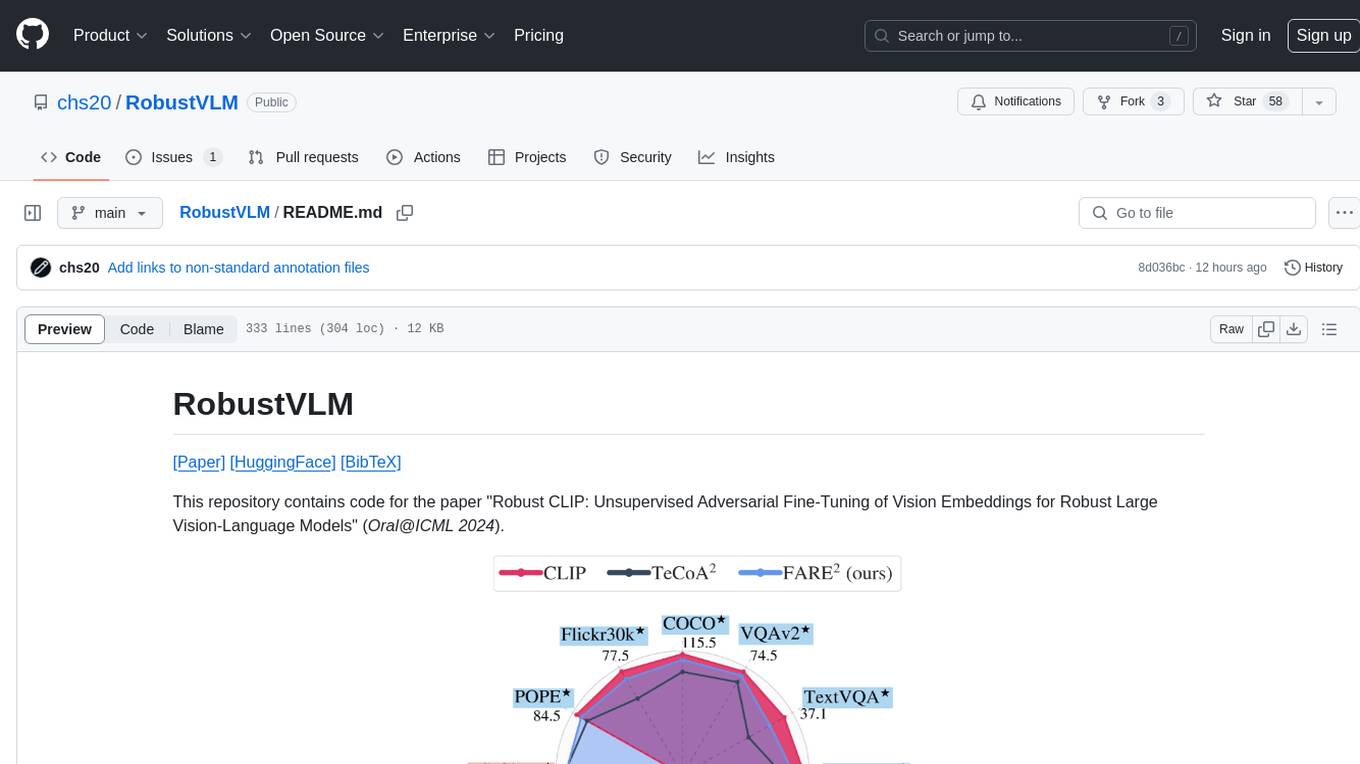
This repository contains code for the paper 'Robust CLIP: Unsupervised Adversarial Fine-Tuning of Vision Embeddings for Robust Large Vision-Language Models'. It focuses on fine-tuning CLIP in an unsupervised manner to enhance its robustness against visual adversarial attacks. By replacing the vision encoder of large vision-language models with the fine-tuned CLIP models, it achieves state-of-the-art adversarial robustness on various vision-language tasks. The repository provides adversarially fine-tuned ViT-L/14 CLIP models and offers insights into zero-shot classification settings and clean accuracy improvements.
README:
[Paper] [HuggingFace] [BibTeX]
This repository contains code for the paper "Robust CLIP: Unsupervised Adversarial Fine-Tuning of Vision Embeddings for Robust Large Vision-Language Models" (Oral@ICML 2024).
We fine-tune CLIP in an unsupervised manner to improve its robustness to visual adversarial attacks. We show that replacing the vision encoder of large vision-language models with our fine-tuned CLIP models yields state-of-the-art adversarial robustness on a variety of vision-language tasks, without requiring any training of the large VLMs themselves. Moreover, we improve the robustness of CLIP to adversarial attacks in zero-shot classification settings, while maintaining higher clean accuracy than previous adversarial fine-tuning methods.
The code is tested with Python 3.11. To install the required packages, run:
pip install -r requirements.txtWe provide the following adversarially fine-tuned ViT-L/14 CLIP models (approx. 1.1 GB each):
| Model | Link | Proposed by | Notes |
|---|---|---|---|
| TeCoA2 | Link | Mao et al. (2023) | Supervised adversarial fine-tuning with $\ell_\infty$ norm, $\varepsilon=\frac{2}{255}$ |
| TeCoA4 | Link | Mao et al. (2023) | Supervised adversarial fine-tuning with $\ell_\infty$ norm, $\varepsilon=\frac{4}{255}$ |
| FARE2 | Link | ours | Unsupervised adversarial fine-tuning with $\ell_\infty$ norm, $\varepsilon=\frac{2}{255}$ |
| FARE4 | Link | ours | Unsupervised adversarial fine-tuning with $\ell_\infty$ norm, $\varepsilon=\frac{4}{255}$ |
The models are also available on HuggingFace.
All models are adversarially fine-tuned for two epochs on ImageNet. TeCoA is trained in a supervised fashion, utilizing ImageNet class labels. FARE, in contrast, does not require any labels for training.
The provided checkpoints correspond to the vision encoder of CLIP. To load the full CLIP model (including the text encoder), you can use the following code:
import torch
from open_clip import create_model_and_transforms
model, _, image_processor = create_model_and_transforms(
'ViT-L-14', pretrained='openai', device='cpu'
)
checkpoint = torch.load('/path/to/fare_eps_2.pt', map_location=torch.device('cpu'))
model.visual.load_state_dict(checkpoint)Alternatively load directly from HuggingFace:
from open_clip import create_model_and_transforms
model, _, image_processor = open_clip.create_model_and_transforms('hf-hub:chs20/fare2-clip')We show a summary of results on zero-shot classification and vision-language tasks for original and fine-tuned ViT-L/14 CLIP models. CLIP-only means that we evaluate the respective CLIP model in a standalone fashion for zero-shot classification, whereas OpenFlamingo and LLaVA evaluation means that we use the respective CLIP model as a vision encoder as part of these large vision-language models. Results for individual zero-shot datasets and more VLM tasks are provided in the paper.
- Clean evaluation:
| CLIP-only | OpenFlamingo 9B | LLaVA 1.5 7B | |||
| Model | Avg. zero-shot | COCO | TextVQA | COCO | TextVQA |
| OpenAI | 73.1 | 79.7 | 23.8 | 115.5 | 37.1 |
| TeCoA2 | 60.0 | 73.5 | 16.6 | 98.4 | 24.1 |
| FARE2 | 67.0 | 79.1 | 21.6 | 109.9 | 31.9 |
| TeCoA4 | 54.2 | 66.9 | 15.4 | 88.3 | 20.7 |
| FARE4 | 61.1 | 74.1 | 18.6 | 102.4 | 27.6 |
- Adversarial evaluation ($\ell_\infty, ~ \varepsilon=\frac{2}{255}$):
| CLIP-only | OpenFlamingo 9B | LLaVA 1.5 7B | |||
| Model | Avg. zero-shot | COCO | TextVQA | COCO | TextVQA |
| Openai | 0.0 | 1.5 | 0.0 | 4.0 | 0.5 |
| TeCoA2 | 43.6 | 31.6 | 3.5 | 44.2 | 12.1 |
| FARE2 | 43.1 | 34.2 | 4.1 | 53.6 | 14.7 |
| TeCoA4 | 42.3 | 28.5 | 2.1 | 50.9 | 12.6 |
| FARE4 | 45.9 | 30.9 | 3.4 | 57.1 | 15.8 |
- Adversarial evaluation ($\ell_\infty, ~ \varepsilon=\frac{4}{255}$):
| CLIP-only | OpenFlamingo 9B | LLaVA 1.5 7B | |||
| Model | Avg. zero-shot | COCO | TextVQA | COCO | TextVQA |
| Openai | 0.0 | 1.1 | 0.0 | 3.1 | 0.0 |
| TeCoA2 | 27.0 | 21.2 | 2.1 | 30.3 | 8.8 |
| FARE2 | 20.5 | 19.5 | 1.9 | 31.0 | 9.1 |
| TeCoA4 | 31.9 | 21.6 | 1.8 | 35.3 | 9.3 |
| FARE4 | 32.4 | 22.8 | 2.9 | 40.9 | 10.9 |
- TeCoA4
python -m train.adversarial_training_clip --clip_model_name ViT-L-14 --pretrained openai --dataset imagenet --imagenet_root /path/to/imagenet --template std --output_normalize True --steps 20000 --warmup 1400 --batch_size 128 --loss ce --opt adamw --lr 1e-5 --wd 1e-4 --attack pgd --inner_loss ce --norm linf --eps 4 --iterations_adv 10 --stepsize_adv 1 --wandb False --output_dir /path/to/out/dir --experiment_name TECOA4 --log_freq 10 --eval_freq 10```- FARE4
python -m train.adversarial_training_clip --clip_model_name ViT-L-14 --pretrained openai --dataset imagenet --imagenet_root /path/to/imagenet --template std --output_normalize False --steps 20000 --warmup 1400 --batch_size 128 --loss l2 --opt adamw --lr 1e-5 --wd 1e-4 --attack pgd --inner_loss l2 --norm linf --eps 4 --iterations_adv 10 --stepsize_adv 1 --wandb False --output_dir /path/to/out/dir --experiment_name FARE4 --log_freq 10 --eval_freq 10Set --eps 2 to obtain TeCoA2 and FARE2 models.
Make sure files in bash directory are executable: chmod +x bash/*
python -m CLIP_eval.clip_robustbench --clip_model_name ViT-L-14 --pretrained /path/to/ckpt.pt --dataset imagenet --imagenet_root /path/to/imagenet --wandb False --norm linf --eps 2Set models to be evaluated in CLIP_benchmark/benchmark/models.txt and datasets in CLIP_benchmark/benchmark/datasets.txt
(the datasets are downloaded from HuggingFace). Then run
cd CLIP_benchmark
./bash/run_benchmark_adv.shIn /bash/llava_eval.sh supply paths for the datasets. The required annotation files for the datasets can be obtained from this HuggingFace repository.
Set --vision_encoder_pretrained to openai or supply path to fine-tuned CLIP model checkpoint.
Then run
./bash/llava_eval.shThe LLaVA model will be automatically downloaded from HuggingFace.
Download the OpenFlamingo 9B model, supply paths in /bash/of_eval_9B.sh and run
./bash/of_eval_9B.shSome non-standard annotation files are supplied here and here.
For targeted attacks on COCO, run
./bash/llava_eval_targeted.shFor targeted attacks on self-selected images, set images and target captions in vlm_eval/run_evaluation_qualitative.py and run
python -m vlm_eval.run_evaluation_qualitative --precision float32 --attack apgd --eps 2 --steps 10000 --vlm_model_name llava --vision_encoder_pretrained openai --verboseWith 10,000 iterations it takes about 2 hours per image on an A100 GPU.
./bash/eval_pope.sh openai # for clean model evaluation
./bash/eval_pope.sh # for robust model evaluation - add path_to_ckpt in bash file./bash/eval_scienceqa.sh openai # for clean model evaluation
./bash/eval_scienceqa.sh # for robust model evaluation - add path_to_ckpt in bash fileThis repository gratefully forks from
If you find this repository useful, please consider citing our paper:
@article{schlarmann2024robustclip,
title={Robust CLIP: Unsupervised Adversarial Fine-Tuning of Vision Embeddings for Robust Large Vision-Language Models},
author={Christian Schlarmann and Naman Deep Singh and Francesco Croce and Matthias Hein},
year={2024},
journal={ICML}
}For Tasks:
Click tags to check more tools for each tasksFor Jobs:
Alternative AI tools for RobustVLM
Similar Open Source Tools

RobustVLM
This repository contains code for the paper 'Robust CLIP: Unsupervised Adversarial Fine-Tuning of Vision Embeddings for Robust Large Vision-Language Models'. It focuses on fine-tuning CLIP in an unsupervised manner to enhance its robustness against visual adversarial attacks. By replacing the vision encoder of large vision-language models with the fine-tuned CLIP models, it achieves state-of-the-art adversarial robustness on various vision-language tasks. The repository provides adversarially fine-tuned ViT-L/14 CLIP models and offers insights into zero-shot classification settings and clean accuracy improvements.
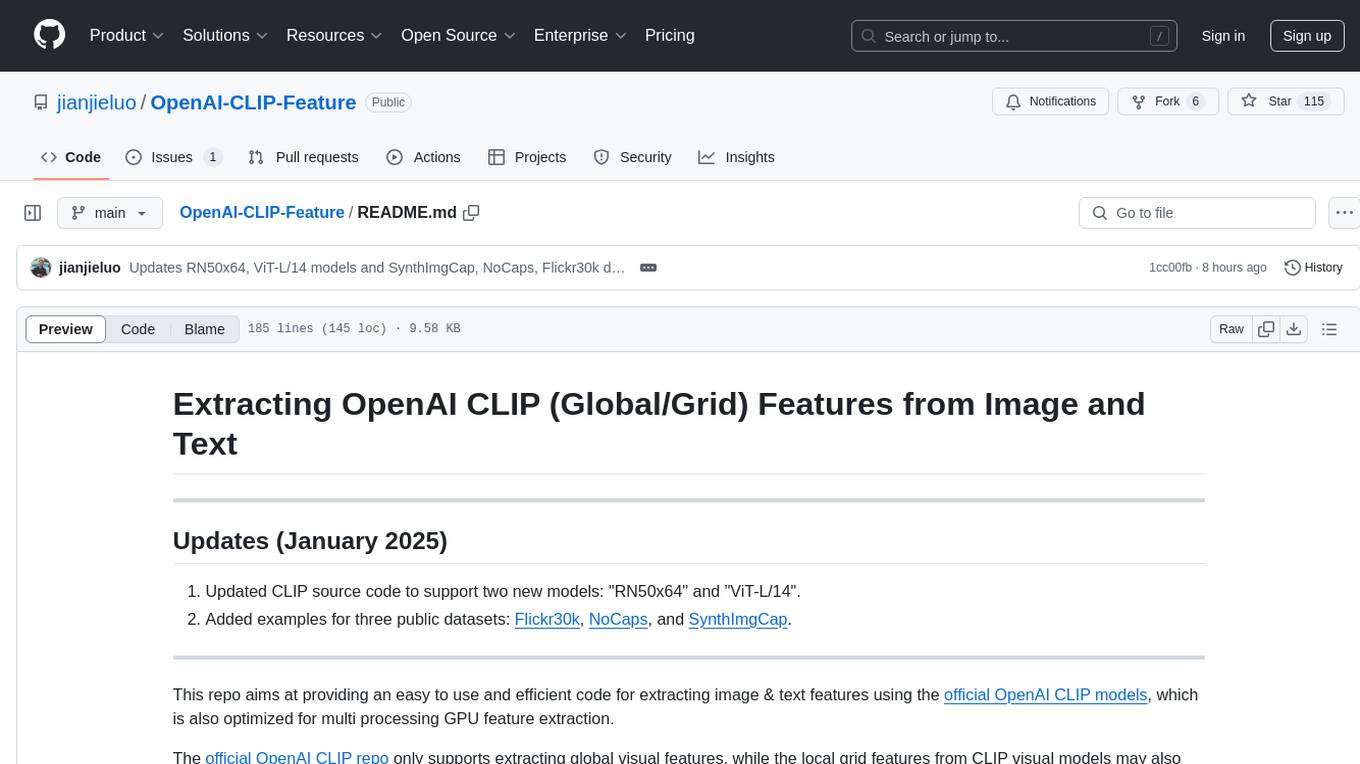
OpenAI-CLIP-Feature
This repository provides code for extracting image and text features using OpenAI CLIP models, supporting both global and local grid visual features. It aims to facilitate multi visual-and-language downstream tasks by allowing users to customize input and output grid resolution easily. The extracted features have shown comparable or superior results in image captioning tasks without hyperparameter tuning. The repo supports various CLIP models and provides detailed information on supported settings and results on MSCOCO image captioning. Users can get started by setting up experiments with the extracted features using X-modaler.
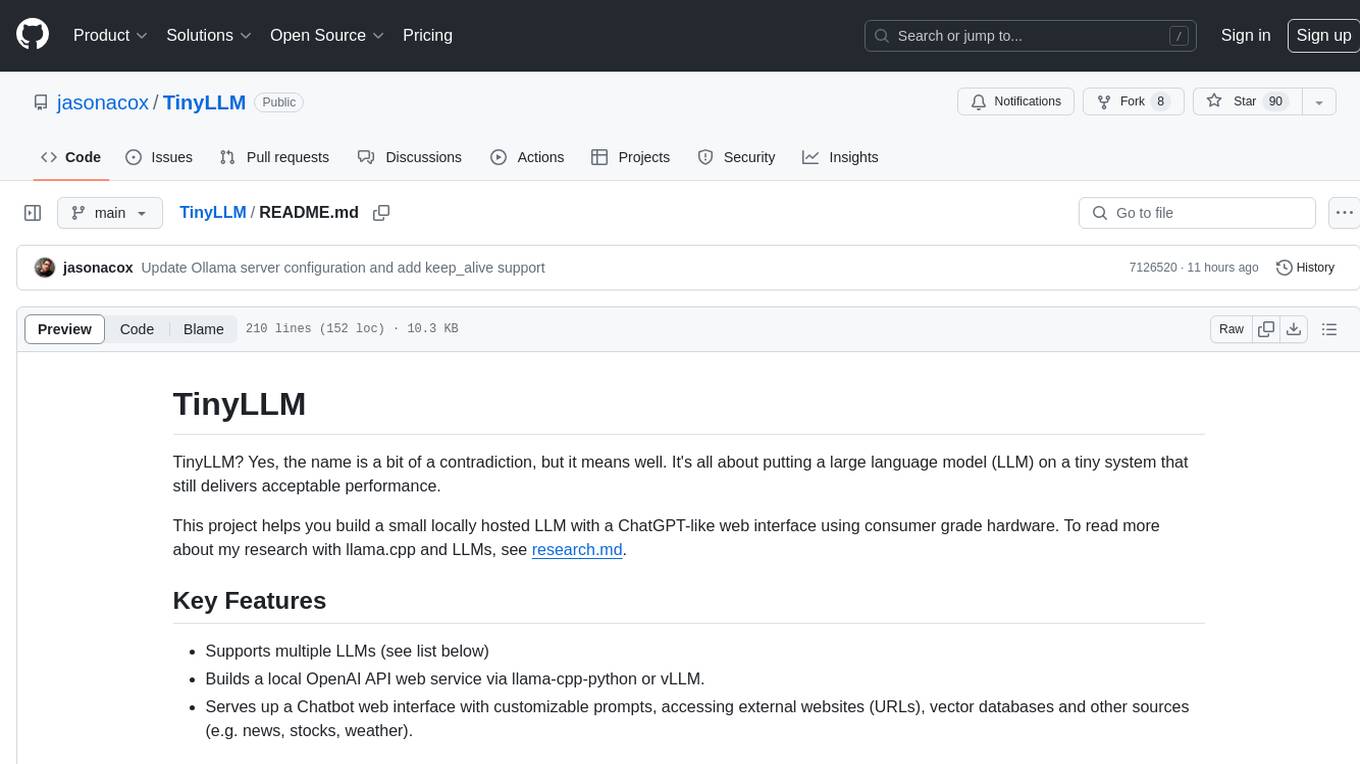
TinyLLM
TinyLLM is a project that helps build a small locally hosted language model with a web interface using consumer-grade hardware. It supports multiple language models, builds a local OpenAI API web service, and serves a Chatbot web interface with customizable prompts. The project requires specific hardware and software configurations for optimal performance. Users can run a local language model using inference servers like vLLM, llama-cpp-python, and Ollama. The Chatbot feature allows users to interact with the language model through a web-based interface, supporting features like summarizing websites, displaying news headlines, stock prices, weather conditions, and using vector databases for queries.
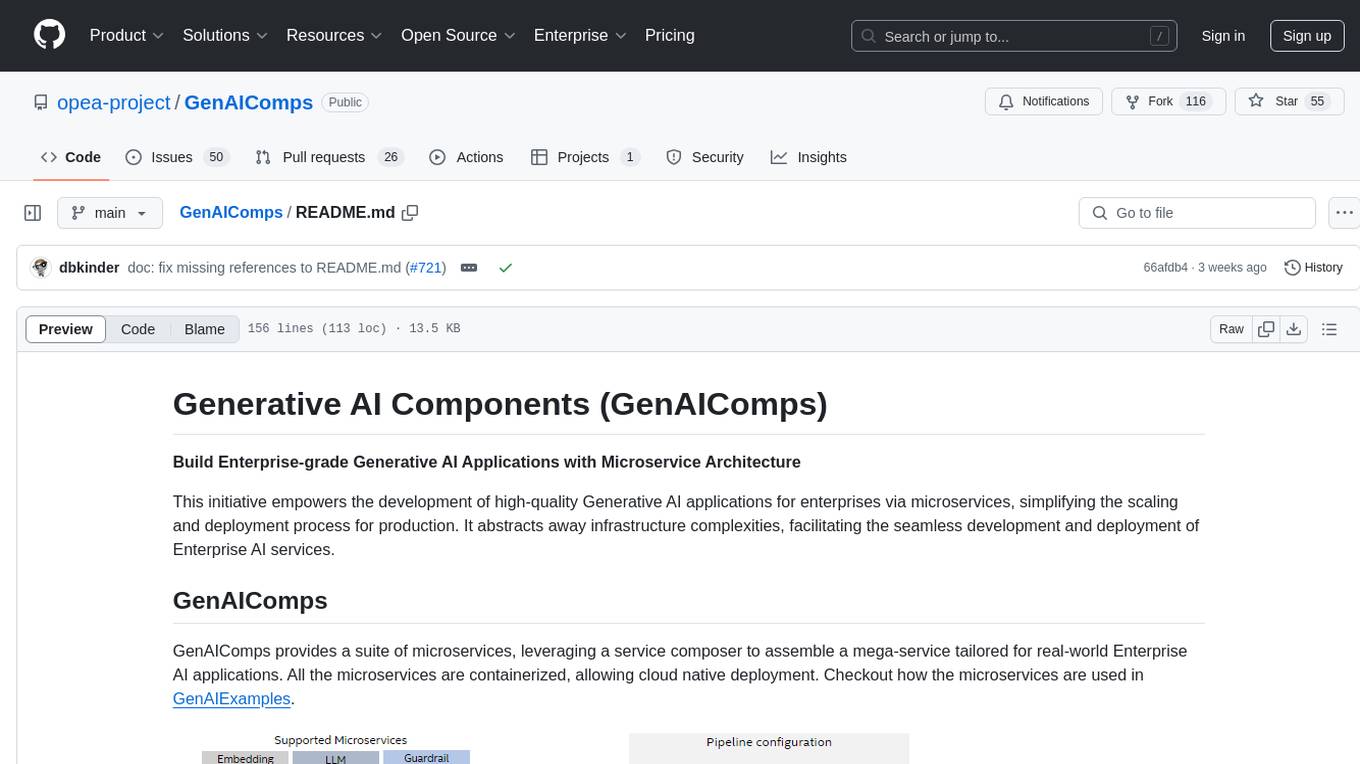
GenAIComps
GenAIComps is an initiative aimed at building enterprise-grade Generative AI applications using a microservice architecture. It simplifies the scaling and deployment process for production, abstracting away infrastructure complexities. GenAIComps provides a suite of containerized microservices that can be assembled into a mega-service tailored for real-world Enterprise AI applications. The modular approach of microservices allows for independent development, deployment, and scaling of individual components, promoting modularity, flexibility, and scalability. The mega-service orchestrates multiple microservices to deliver comprehensive solutions, encapsulating complex business logic and workflow orchestration. The gateway serves as the interface for users to access the mega-service, providing customized access based on user requirements.
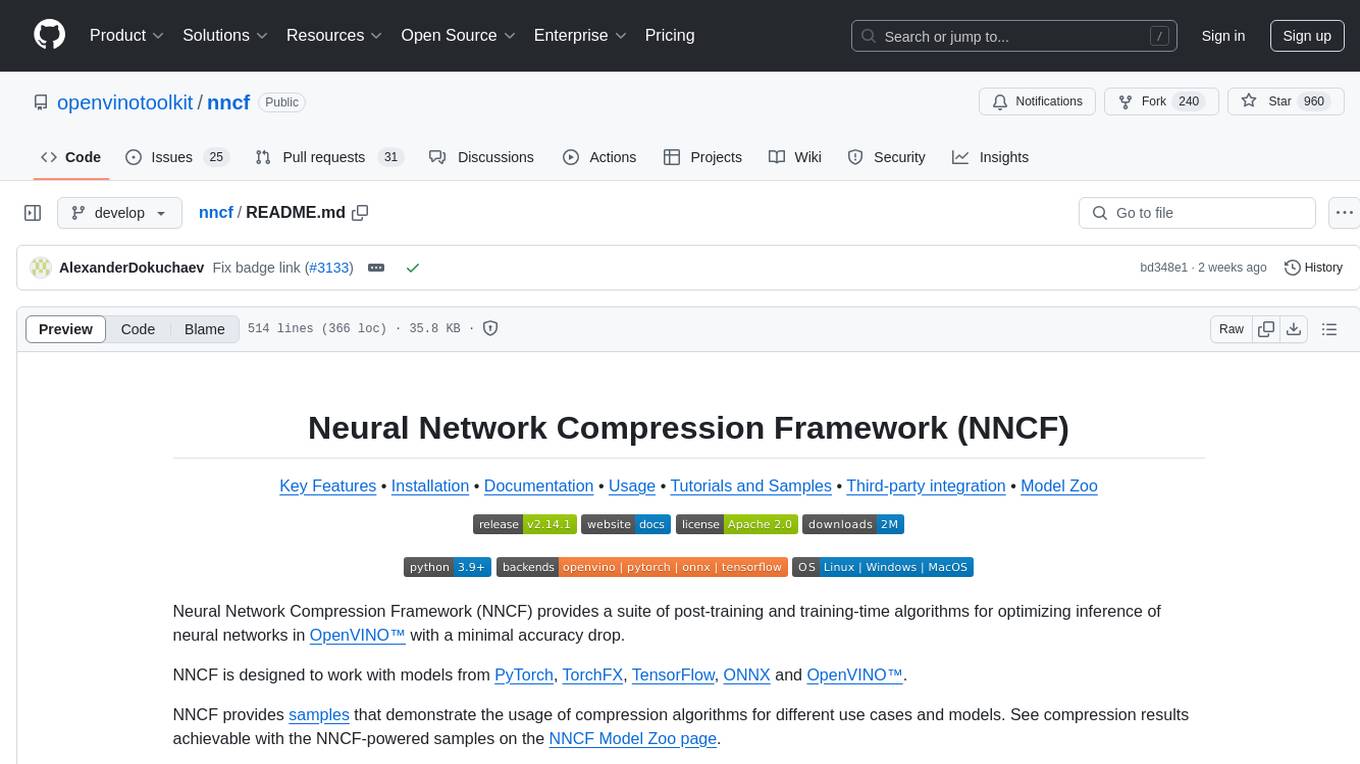
nncf
Neural Network Compression Framework (NNCF) provides a suite of post-training and training-time algorithms for optimizing inference of neural networks in OpenVINO™ with a minimal accuracy drop. It is designed to work with models from PyTorch, TorchFX, TensorFlow, ONNX, and OpenVINO™. NNCF offers samples demonstrating compression algorithms for various use cases and models, with the ability to add different compression algorithms easily. It supports GPU-accelerated layers, distributed training, and seamless combination of pruning, sparsity, and quantization algorithms. NNCF allows exporting compressed models to ONNX or TensorFlow formats for use with OpenVINO™ toolkit, and supports Accuracy-Aware model training pipelines via Adaptive Compression Level Training and Early Exit Training.
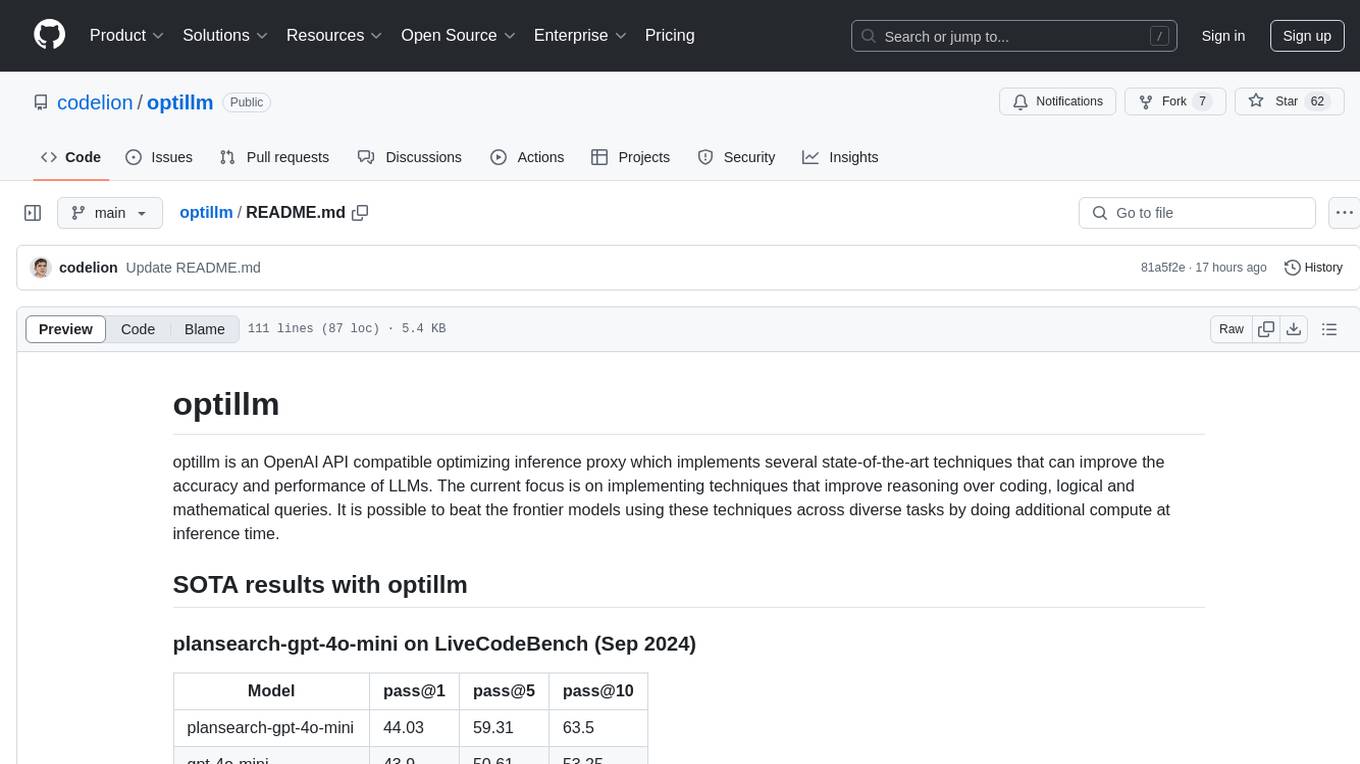
optillm
optillm is an OpenAI API compatible optimizing inference proxy implementing state-of-the-art techniques to enhance accuracy and performance of LLMs, focusing on reasoning over coding, logical, and mathematical queries. By leveraging additional compute at inference time, it surpasses frontier models across diverse tasks.
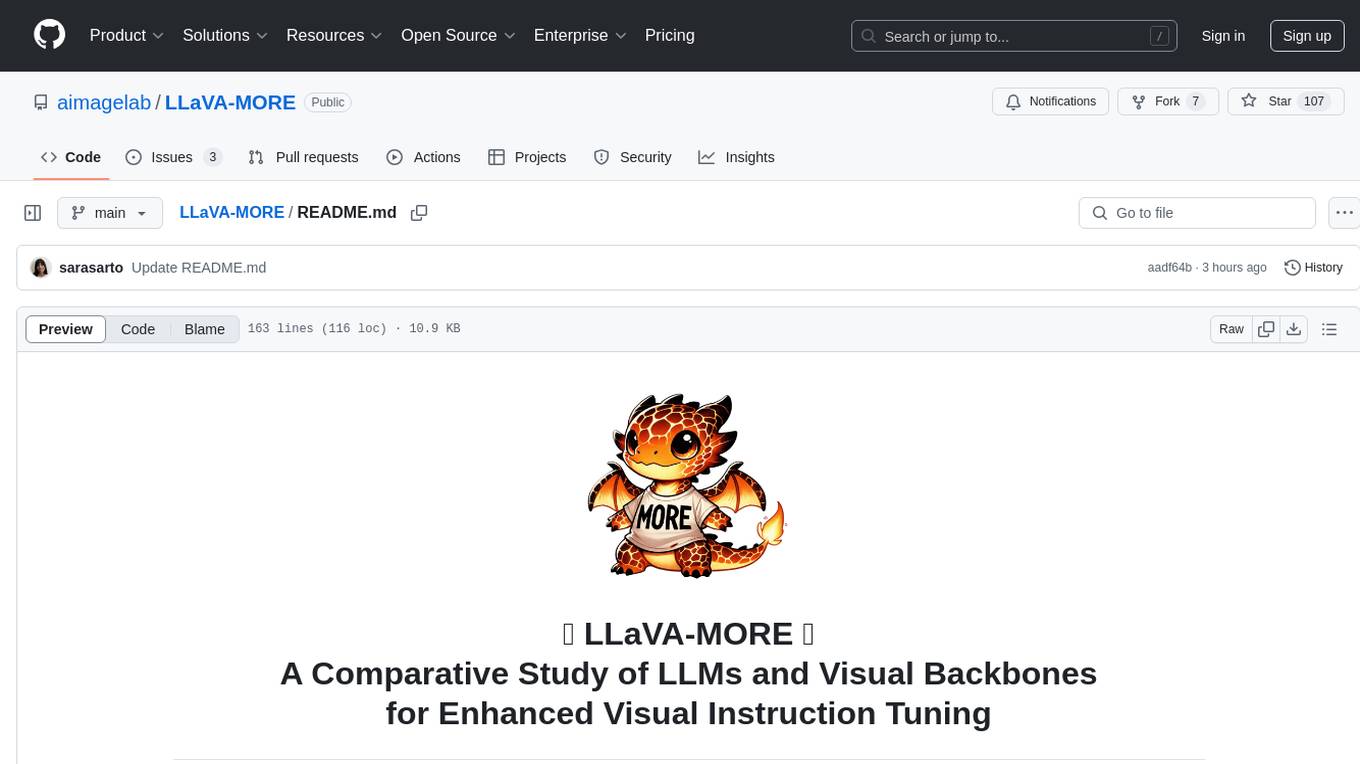
LLaVA-MORE
LLaVA-MORE is a new family of Multimodal Language Models (MLLMs) that integrates recent language models with diverse visual backbones. The repository provides a unified training protocol for fair comparisons across all architectures and releases training code and scripts for distributed training. It aims to enhance Multimodal LLM performance and offers various models for different tasks. Users can explore different visual backbones like SigLIP and methods for managing image resolutions (S2) to improve the connection between images and language. The repository is a starting point for expanding the study of Multimodal LLMs and enhancing new features in the field.
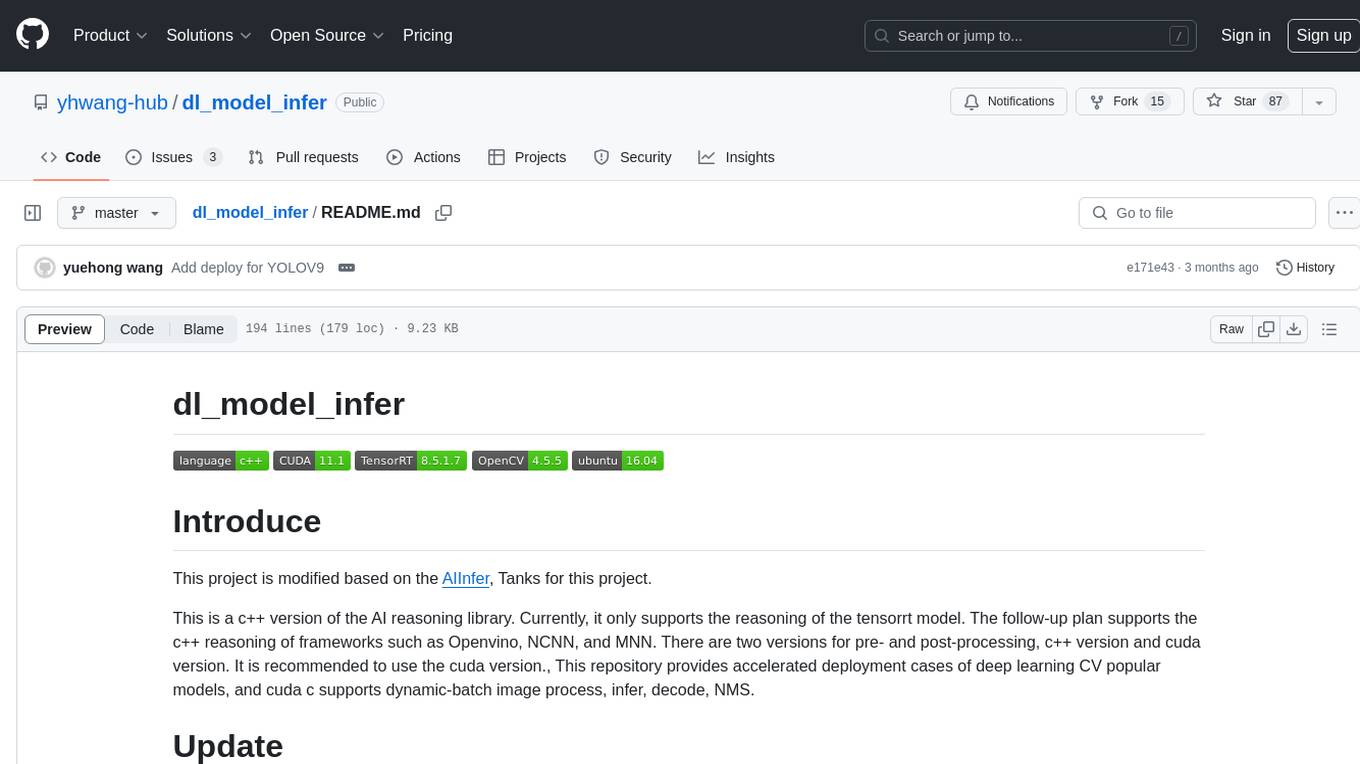
dl_model_infer
This project is a c++ version of the AI reasoning library that supports the reasoning of tensorrt models. It provides accelerated deployment cases of deep learning CV popular models and supports dynamic-batch image processing, inference, decode, and NMS. The project has been updated with various models and provides tutorials for model exports. It also includes a producer-consumer inference model for specific tasks. The project directory includes implementations for model inference applications, backend reasoning classes, post-processing, pre-processing, and target detection and tracking. Speed tests have been conducted on various models, and onnx downloads are available for different models.
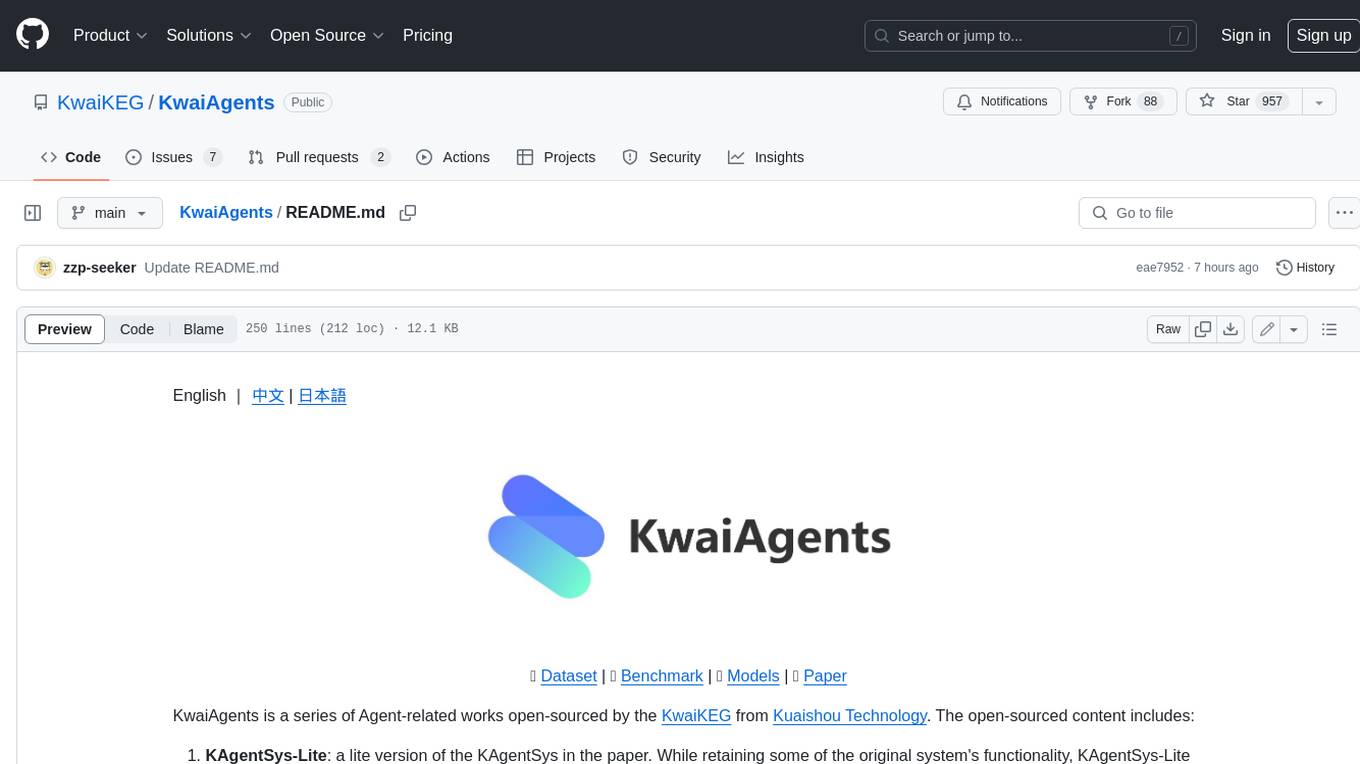
KwaiAgents
KwaiAgents is a series of Agent-related works open-sourced by the [KwaiKEG](https://github.com/KwaiKEG) from [Kuaishou Technology](https://www.kuaishou.com/en). The open-sourced content includes: 1. **KAgentSys-Lite**: a lite version of the KAgentSys in the paper. While retaining some of the original system's functionality, KAgentSys-Lite has certain differences and limitations when compared to its full-featured counterpart, such as: (1) a more limited set of tools; (2) a lack of memory mechanisms; (3) slightly reduced performance capabilities; and (4) a different codebase, as it evolves from open-source projects like BabyAGI and Auto-GPT. Despite these modifications, KAgentSys-Lite still delivers comparable performance among numerous open-source Agent systems available. 2. **KAgentLMs**: a series of large language models with agent capabilities such as planning, reflection, and tool-use, acquired through the Meta-agent tuning proposed in the paper. 3. **KAgentInstruct**: over 200k Agent-related instructions finetuning data (partially human-edited) proposed in the paper. 4. **KAgentBench**: over 3,000 human-edited, automated evaluation data for testing Agent capabilities, with evaluation dimensions including planning, tool-use, reflection, concluding, and profiling.
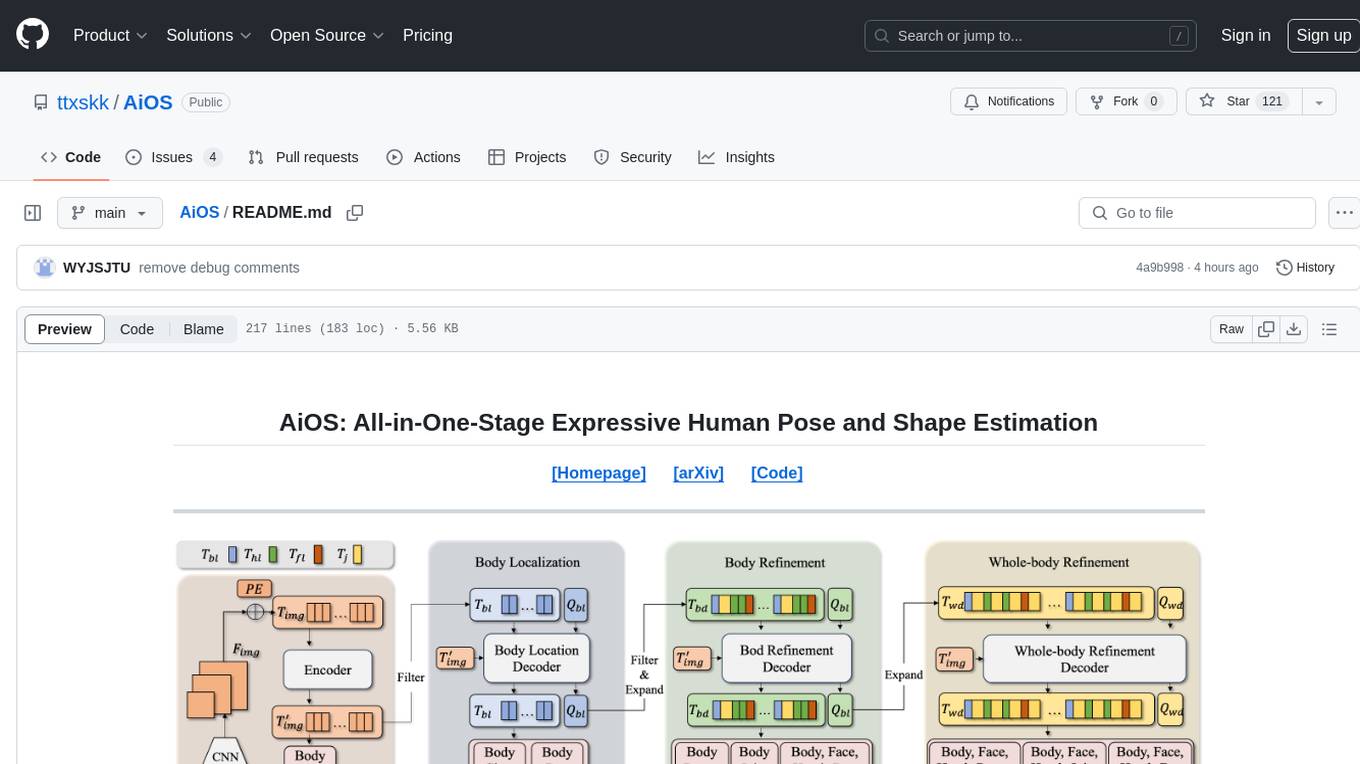
AiOS
AiOS is a tool for human pose and shape estimation, performing human localization and SMPL-X estimation in a progressive manner. It consists of body localization, body refinement, and whole-body refinement stages. Users can download datasets for evaluation, SMPL-X body models, and AiOS checkpoint. Installation involves creating a conda virtual environment, installing PyTorch, torchvision, Pytorch3D, MMCV, and other dependencies. Inference requires placing the video for inference and pretrained models in specific directories. Test results are provided for NMVE, NMJE, MVE, and MPJPE on datasets like BEDLAM and AGORA. Users can run scripts for AGORA validation, AGORA test leaderboard, and BEDLAM leaderboard. The tool acknowledges codes from MMHuman3D, ED-Pose, and SMPLer-X.
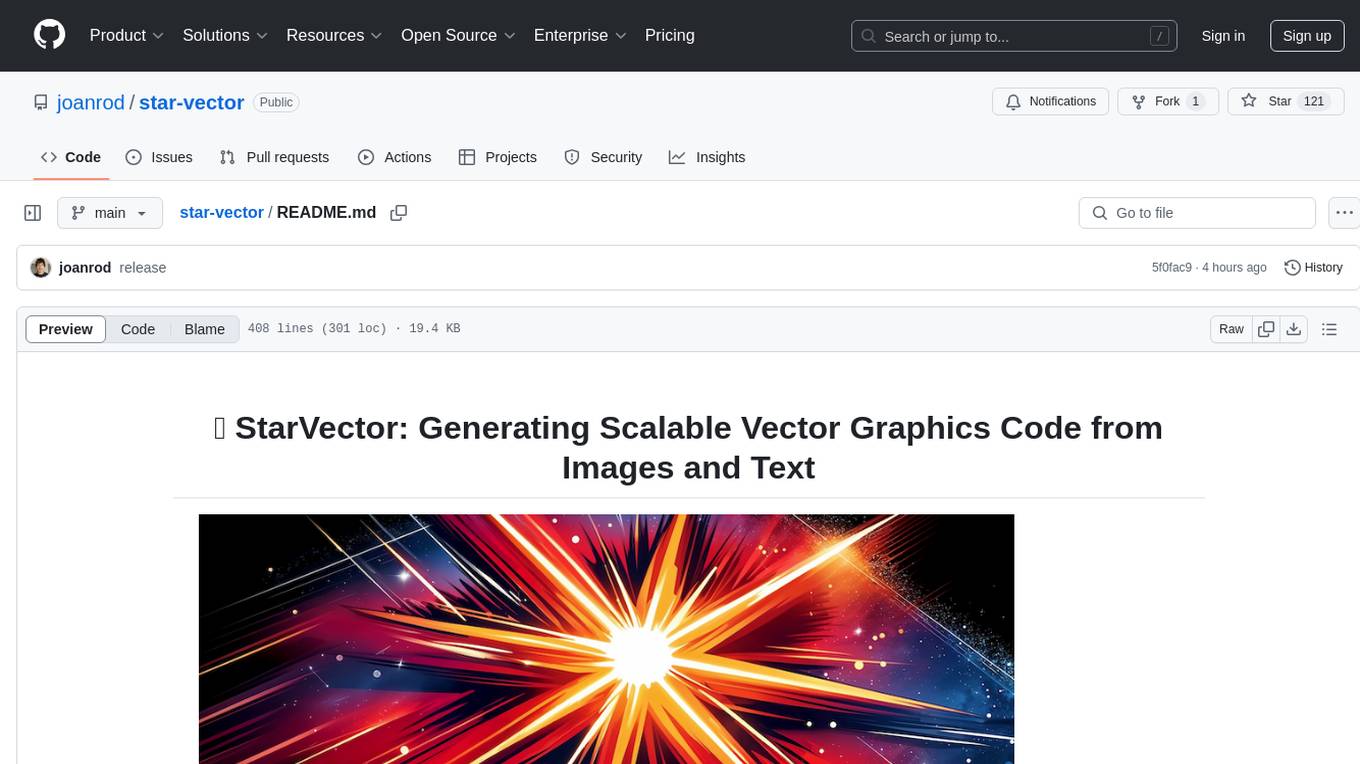
star-vector
StarVector is a multimodal vision-language model for Scalable Vector Graphics (SVG) generation. It can be used to perform image2SVG and text2SVG generation. StarVector works directly in the SVG code space, leveraging visual understanding to apply accurate SVG primitives. It achieves state-of-the-art performance in producing compact and semantically rich SVGs. The tool provides Hugging Face model checkpoints for image2SVG vectorization, with models like StarVector-8B and StarVector-1B. It also offers datasets like SVG-Stack, SVG-Fonts, SVG-Icons, SVG-Emoji, and SVG-Diagrams for evaluation. StarVector can be trained using Deepspeed or FSDP for tasks like Image2SVG and Text2SVG generation. The tool provides a demo with options for HuggingFace generation or VLLM backend for faster generation speed.
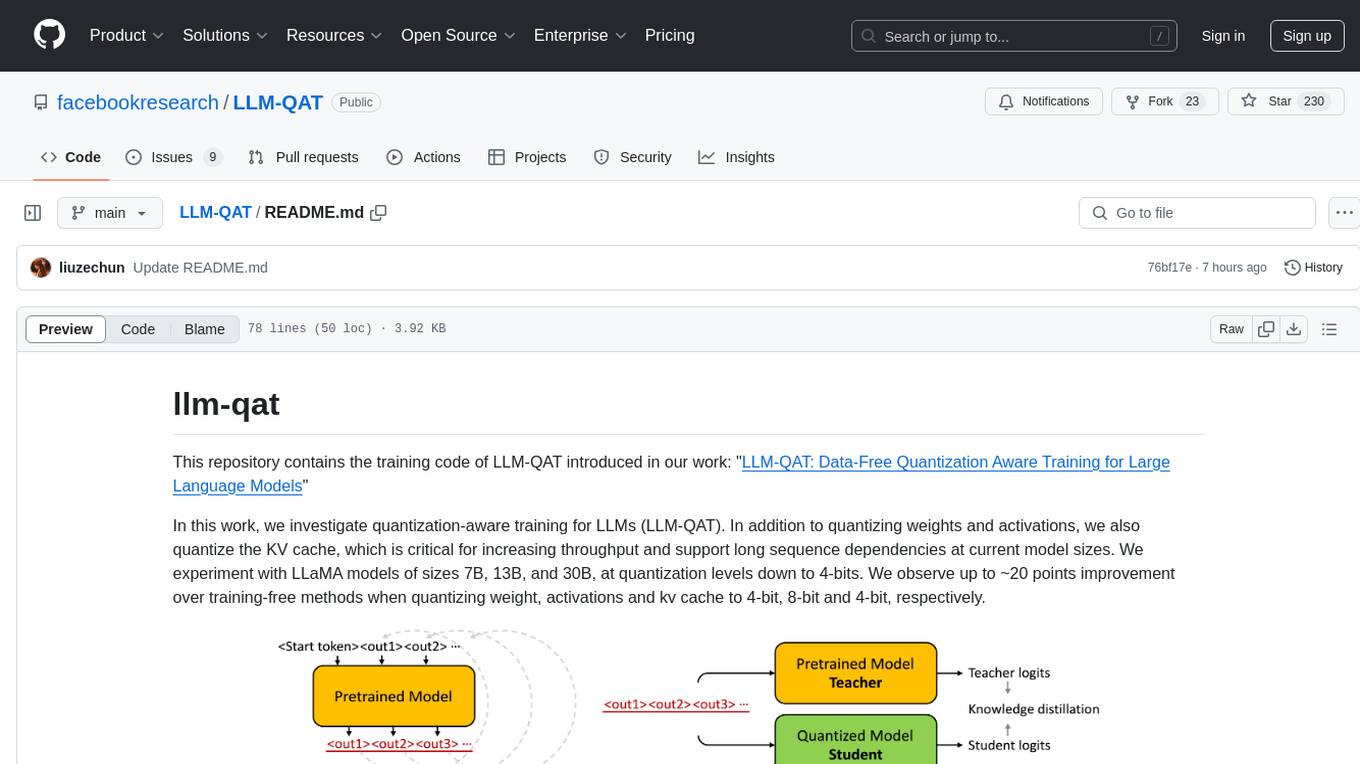
LLM-QAT
This repository contains the training code of LLM-QAT for large language models. The work investigates quantization-aware training for LLMs, including quantizing weights, activations, and the KV cache. Experiments were conducted on LLaMA models of sizes 7B, 13B, and 30B, at quantization levels down to 4-bits. Significant improvements were observed when quantizing weight, activations, and kv cache to 4-bit, 8-bit, and 4-bit, respectively.

llava-docker
This Docker image for LLaVA (Large Language and Vision Assistant) provides a convenient way to run LLaVA locally or on RunPod. LLaVA is a powerful AI tool that combines natural language processing and computer vision capabilities. With this Docker image, you can easily access LLaVA's functionalities for various tasks, including image captioning, visual question answering, text summarization, and more. The image comes pre-installed with LLaVA v1.2.0, Torch 2.1.2, xformers 0.0.23.post1, and other necessary dependencies. You can customize the model used by setting the MODEL environment variable. The image also includes a Jupyter Lab environment for interactive development and exploration. Overall, this Docker image offers a comprehensive and user-friendly platform for leveraging LLaVA's capabilities.
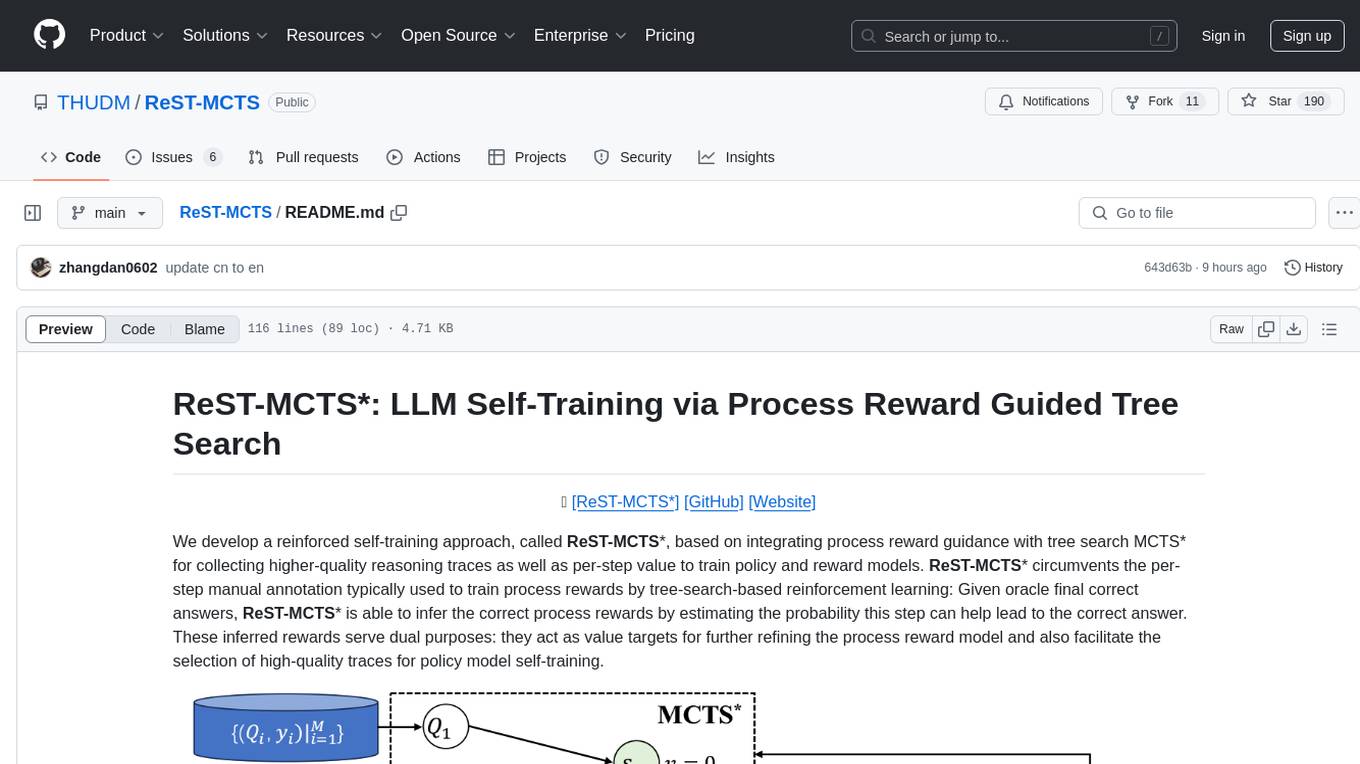
ReST-MCTS
ReST-MCTS is a reinforced self-training approach that integrates process reward guidance with tree search MCTS to collect higher-quality reasoning traces and per-step value for training policy and reward models. It eliminates the need for manual per-step annotation by estimating the probability of steps leading to correct answers. The inferred rewards refine the process reward model and aid in selecting high-quality traces for policy model self-training.
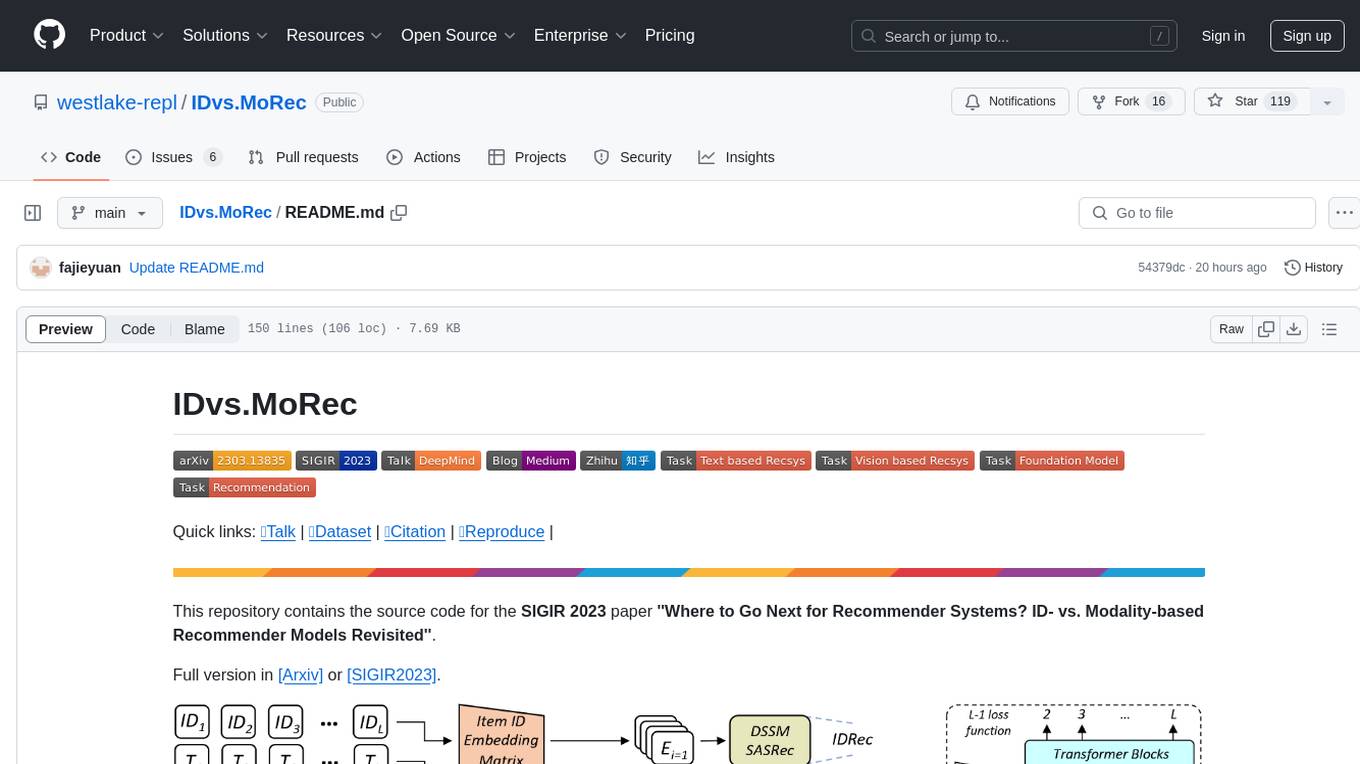
IDvs.MoRec
This repository contains the source code for the SIGIR 2023 paper 'Where to Go Next for Recommender Systems? ID- vs. Modality-based Recommender Models Revisited'. It provides resources for evaluating foundation, transferable, multi-modal, and LLM recommendation models, along with datasets, pre-trained models, and training strategies for IDRec and MoRec using in-batch debiased cross-entropy loss. The repository also offers large-scale datasets, code for SASRec with in-batch debias cross-entropy loss, and information on joining the lab for research opportunities.
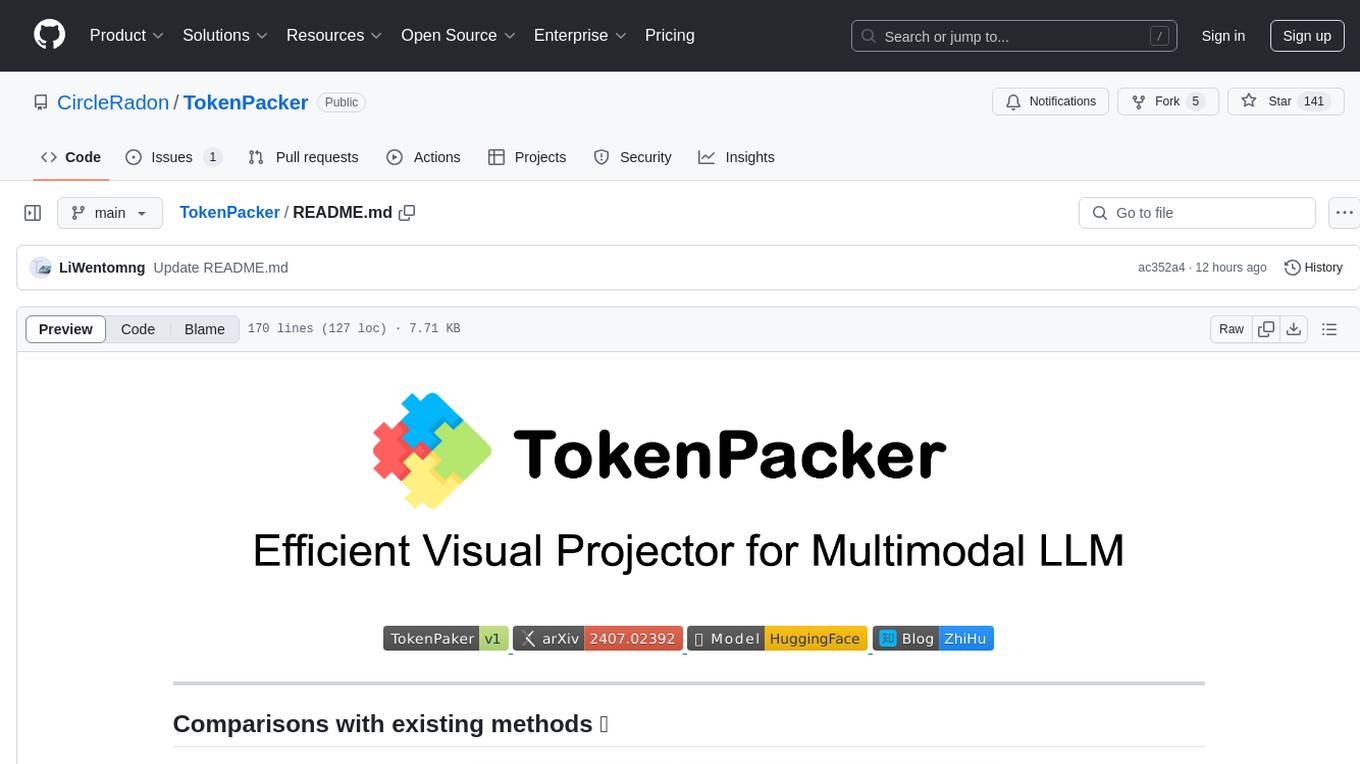
TokenPacker
TokenPacker is a novel visual projector that compresses visual tokens by 75%∼89% with high efficiency. It adopts a 'coarse-to-fine' scheme to generate condensed visual tokens, achieving comparable or better performance across diverse benchmarks. The tool includes TokenPacker for general use and TokenPacker-HD for high-resolution image understanding. It provides training scripts, checkpoints, and supports various compression ratios and patch numbers.
For similar tasks
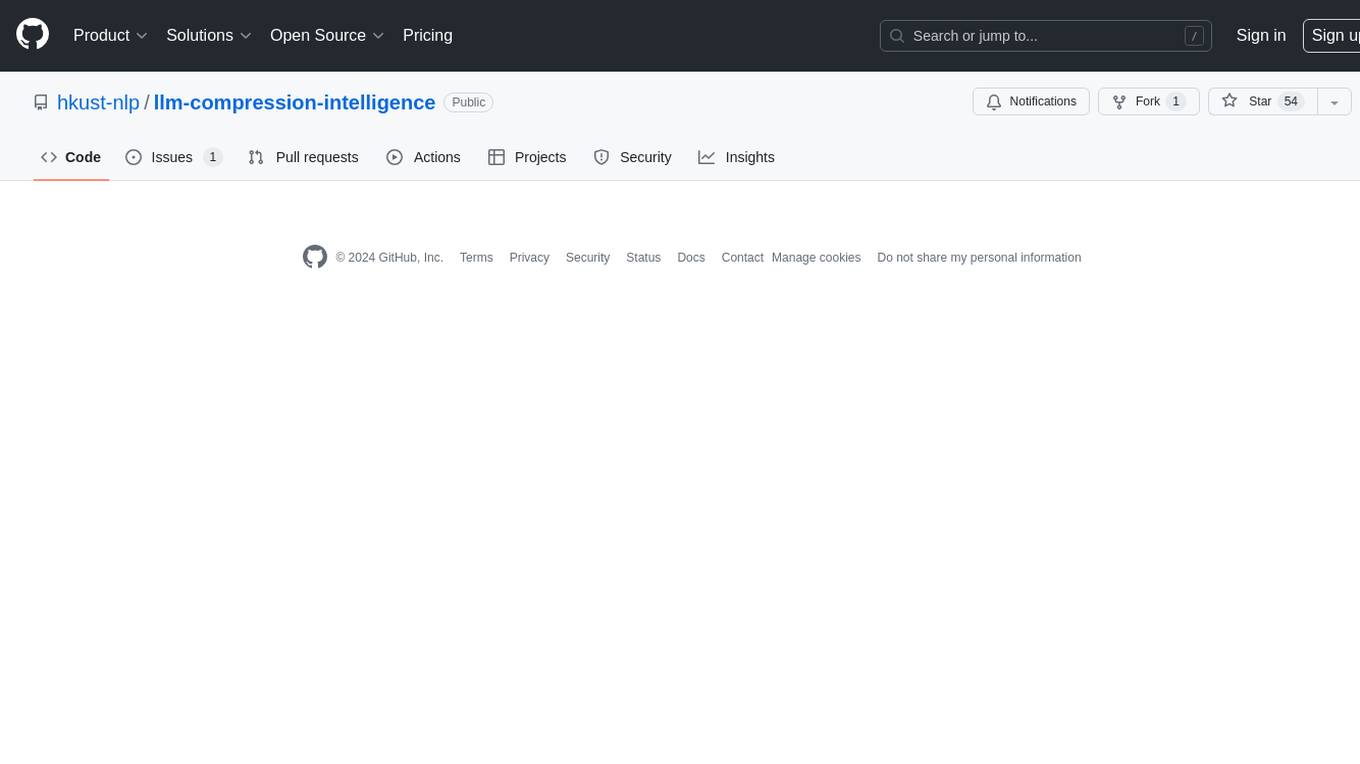
llm-compression-intelligence
This repository presents the findings of the paper "Compression Represents Intelligence Linearly". The study reveals a strong linear correlation between the intelligence of LLMs, as measured by benchmark scores, and their ability to compress external text corpora. Compression efficiency, derived from raw text corpora, serves as a reliable evaluation metric that is linearly associated with model capabilities. The repository includes the compression corpora used in the paper, code for computing compression efficiency, and data collection and processing pipelines.
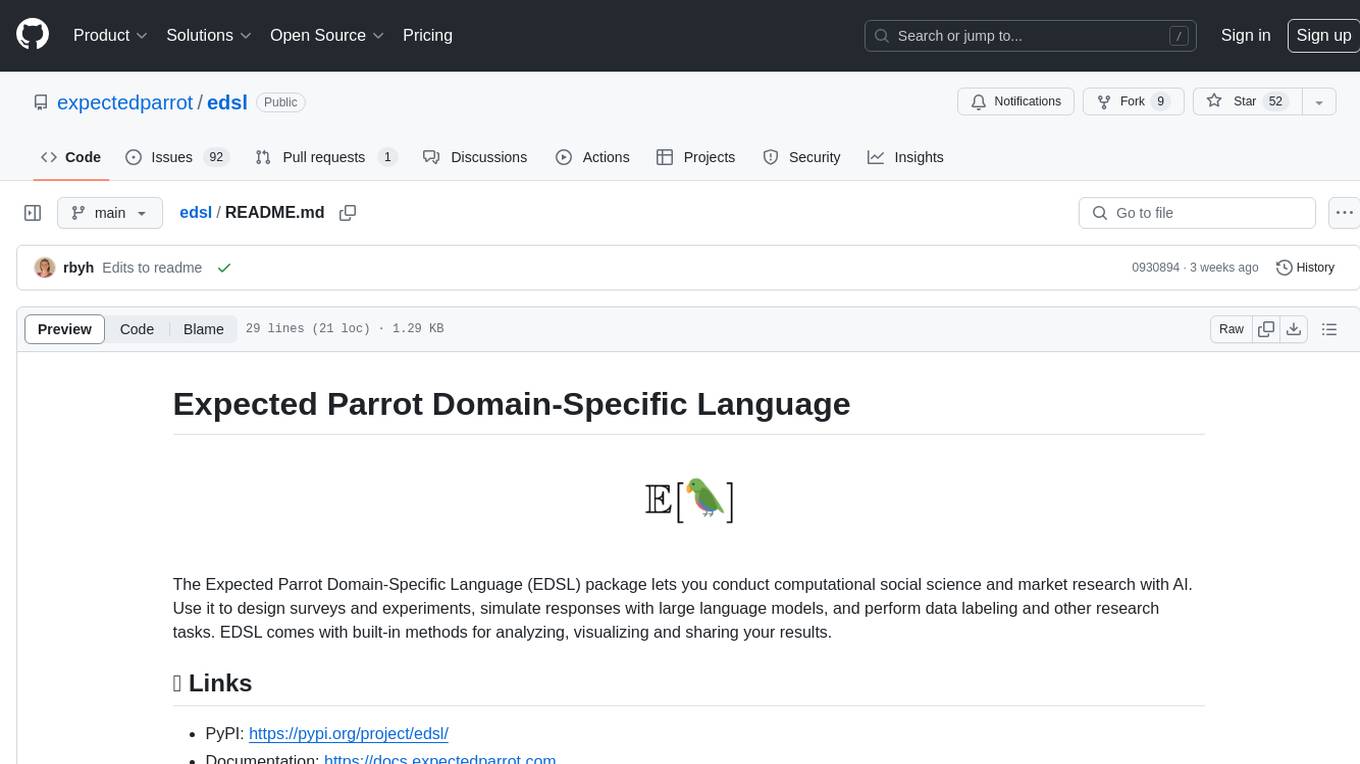
edsl
The Expected Parrot Domain-Specific Language (EDSL) package enables users to conduct computational social science and market research with AI. It facilitates designing surveys and experiments, simulating responses using large language models, and performing data labeling and other research tasks. EDSL includes built-in methods for analyzing, visualizing, and sharing research results. It is compatible with Python 3.9 - 3.11 and requires API keys for LLMs stored in a `.env` file.
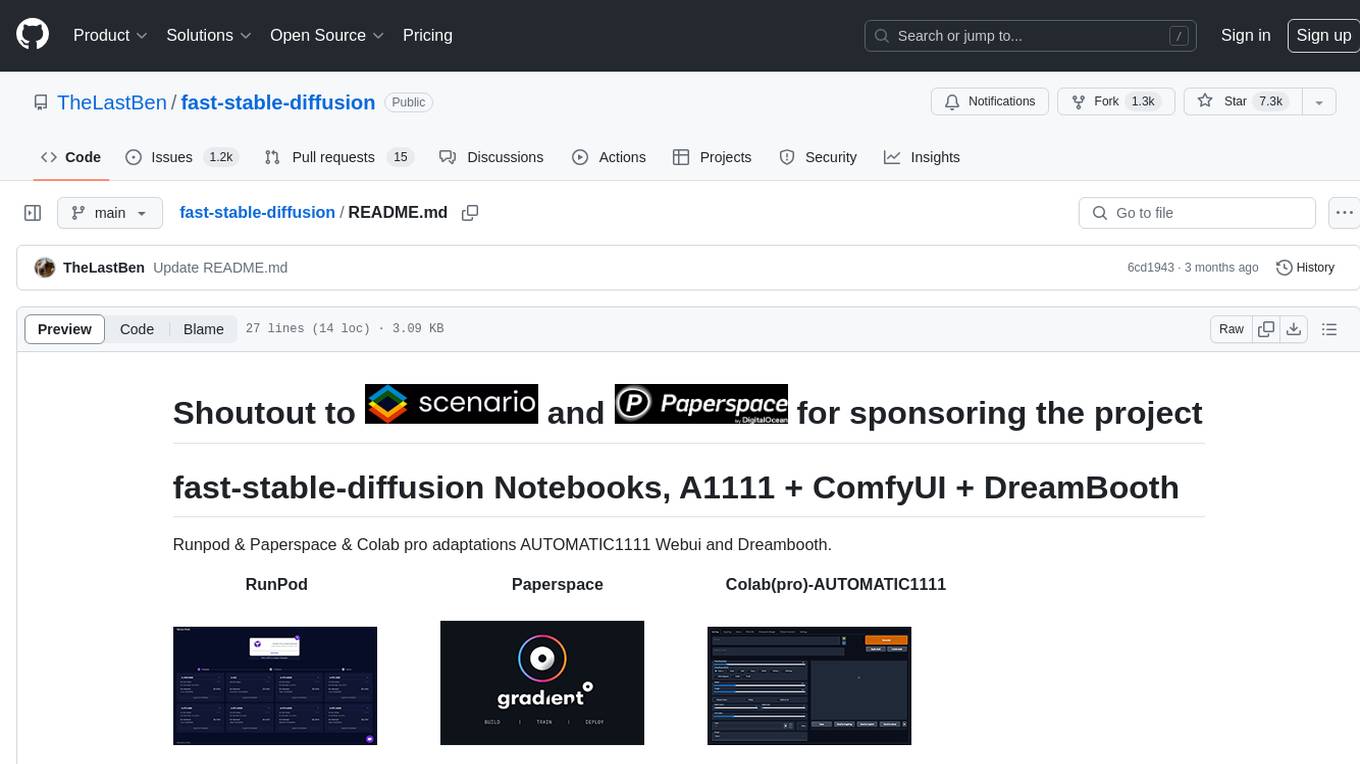
fast-stable-diffusion
Fast-stable-diffusion is a project that offers notebooks for RunPod, Paperspace, and Colab Pro adaptations with AUTOMATIC1111 Webui and Dreambooth. It provides tools for running and implementing Dreambooth, a stable diffusion project. The project includes implementations by XavierXiao and is sponsored by Runpod, Paperspace, and Colab Pro.

RobustVLM
This repository contains code for the paper 'Robust CLIP: Unsupervised Adversarial Fine-Tuning of Vision Embeddings for Robust Large Vision-Language Models'. It focuses on fine-tuning CLIP in an unsupervised manner to enhance its robustness against visual adversarial attacks. By replacing the vision encoder of large vision-language models with the fine-tuned CLIP models, it achieves state-of-the-art adversarial robustness on various vision-language tasks. The repository provides adversarially fine-tuned ViT-L/14 CLIP models and offers insights into zero-shot classification settings and clean accuracy improvements.
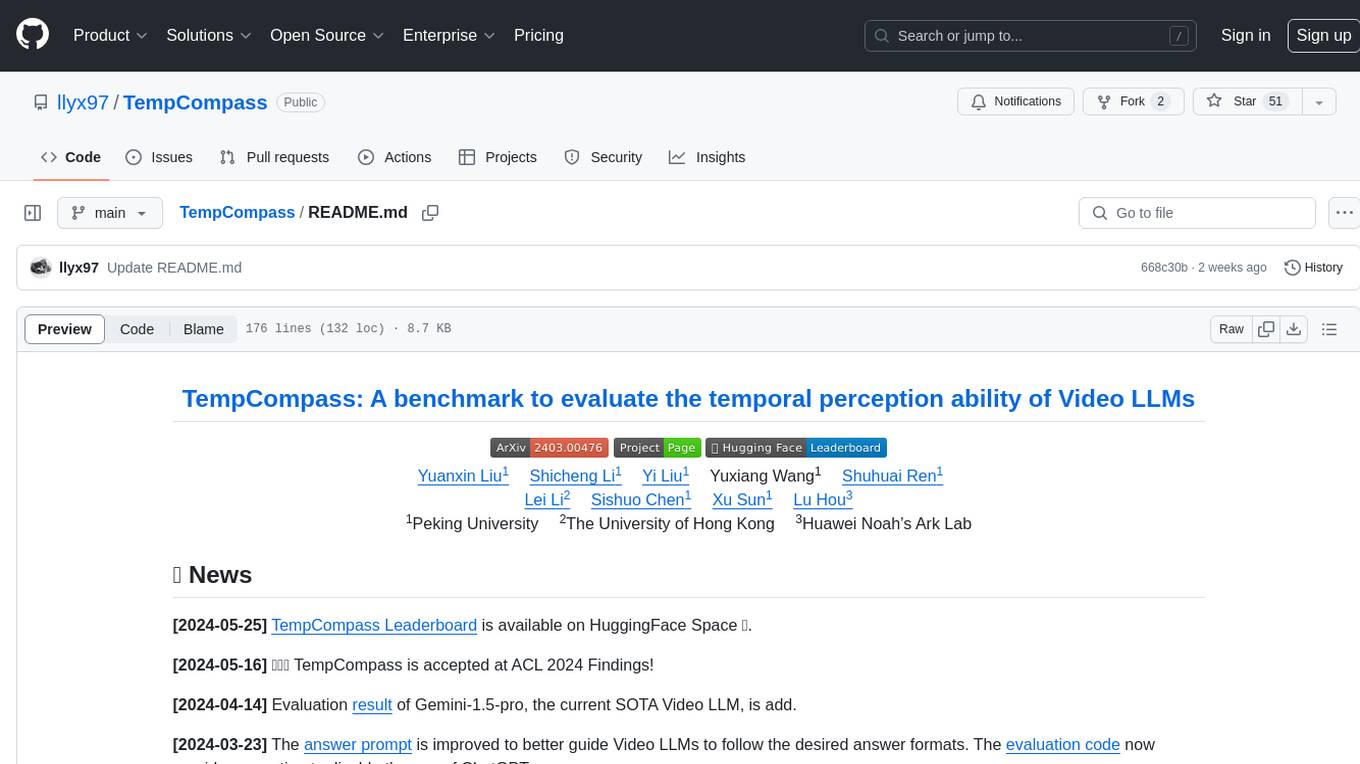
TempCompass
TempCompass is a benchmark designed to evaluate the temporal perception ability of Video LLMs. It encompasses a diverse set of temporal aspects and task formats to comprehensively assess the capability of Video LLMs in understanding videos. The benchmark includes conflicting videos to prevent models from relying on single-frame bias and language priors. Users can clone the repository, install required packages, prepare data, run inference using examples like Video-LLaVA and Gemini, and evaluate the performance of their models across different tasks such as Multi-Choice QA, Yes/No QA, Caption Matching, and Caption Generation.
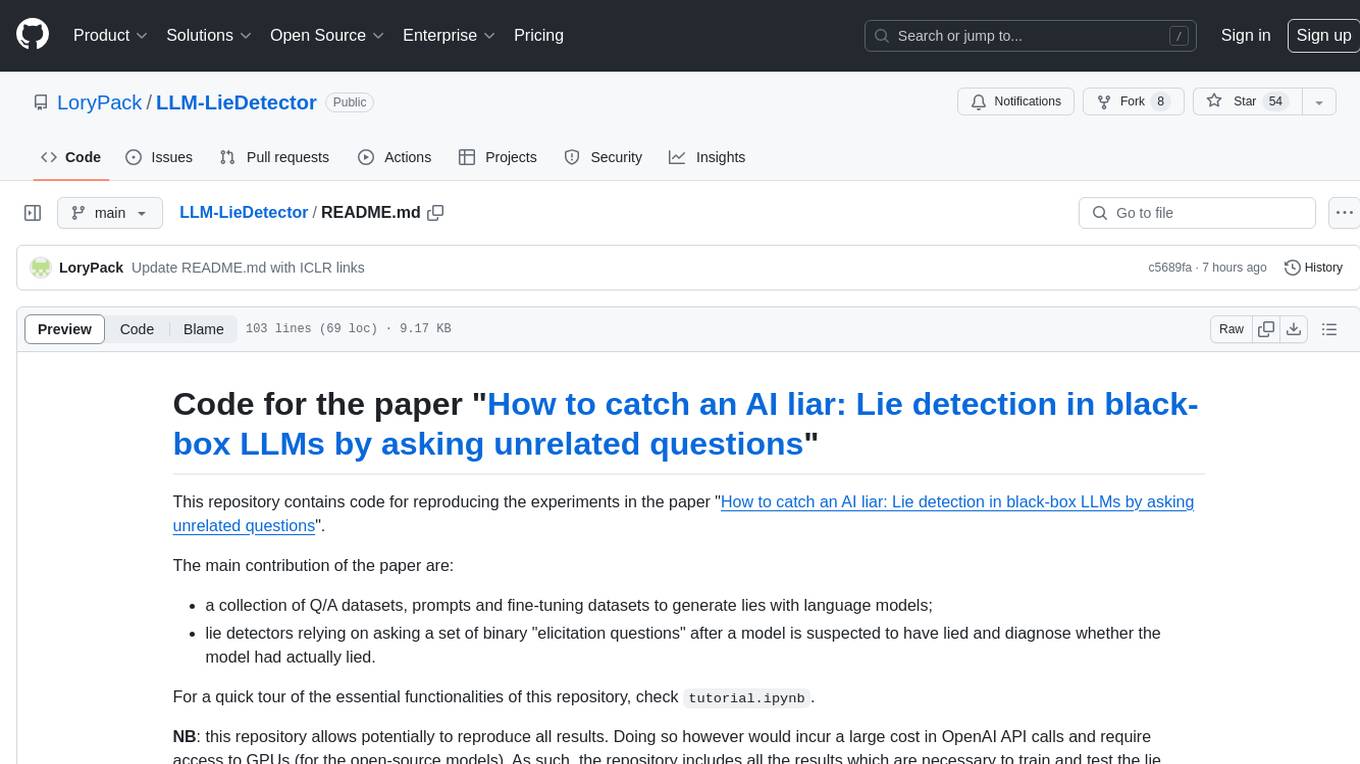
LLM-LieDetector
This repository contains code for reproducing experiments on lie detection in black-box LLMs by asking unrelated questions. It includes Q/A datasets, prompts, and fine-tuning datasets for generating lies with language models. The lie detectors rely on asking binary 'elicitation questions' to diagnose whether the model has lied. The code covers generating lies from language models, training and testing lie detectors, and generalization experiments. It requires access to GPUs and OpenAI API calls for running experiments with open-source models. Results are stored in the repository for reproducibility.
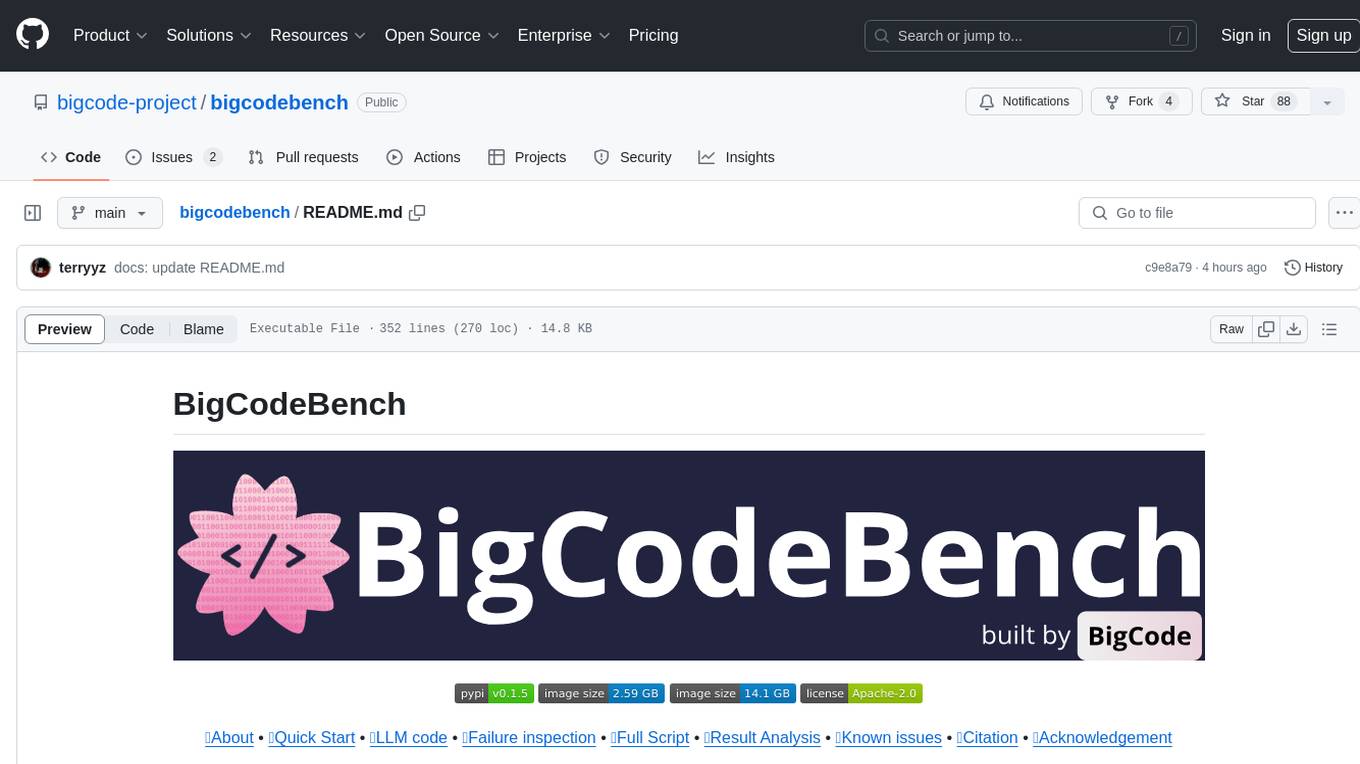
bigcodebench
BigCodeBench is an easy-to-use benchmark for code generation with practical and challenging programming tasks. It aims to evaluate the true programming capabilities of large language models (LLMs) in a more realistic setting. The benchmark is designed for HumanEval-like function-level code generation tasks, but with much more complex instructions and diverse function calls. BigCodeBench focuses on the evaluation of LLM4Code with diverse function calls and complex instructions, providing precise evaluation & ranking and pre-generated samples to accelerate code intelligence research. It inherits the design of the EvalPlus framework but differs in terms of execution environment and test evaluation.
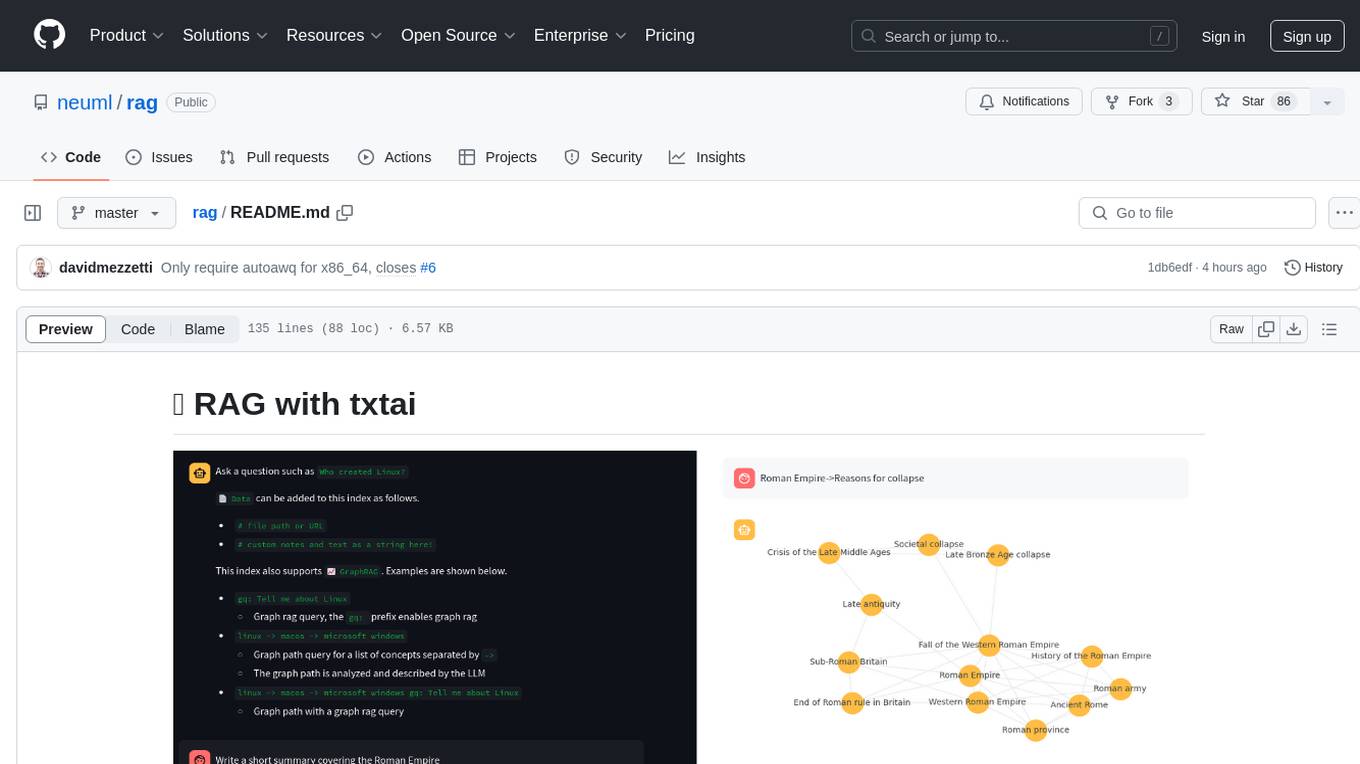
rag
RAG with txtai is a Retrieval Augmented Generation (RAG) Streamlit application that helps generate factually correct content by limiting the context in which a Large Language Model (LLM) can generate answers. It supports two categories of RAG: Vector RAG, where context is supplied via a vector search query, and Graph RAG, where context is supplied via a graph path traversal query. The application allows users to run queries, add data to the index, and configure various parameters to control its behavior.
For similar jobs

weave
Weave is a toolkit for developing Generative AI applications, built by Weights & Biases. With Weave, you can log and debug language model inputs, outputs, and traces; build rigorous, apples-to-apples evaluations for language model use cases; and organize all the information generated across the LLM workflow, from experimentation to evaluations to production. Weave aims to bring rigor, best-practices, and composability to the inherently experimental process of developing Generative AI software, without introducing cognitive overhead.

LLMStack
LLMStack is a no-code platform for building generative AI agents, workflows, and chatbots. It allows users to connect their own data, internal tools, and GPT-powered models without any coding experience. LLMStack can be deployed to the cloud or on-premise and can be accessed via HTTP API or triggered from Slack or Discord.

VisionCraft
The VisionCraft API is a free API for using over 100 different AI models. From images to sound.

kaito
Kaito is an operator that automates the AI/ML inference model deployment in a Kubernetes cluster. It manages large model files using container images, avoids tuning deployment parameters to fit GPU hardware by providing preset configurations, auto-provisions GPU nodes based on model requirements, and hosts large model images in the public Microsoft Container Registry (MCR) if the license allows. Using Kaito, the workflow of onboarding large AI inference models in Kubernetes is largely simplified.

PyRIT
PyRIT is an open access automation framework designed to empower security professionals and ML engineers to red team foundation models and their applications. It automates AI Red Teaming tasks to allow operators to focus on more complicated and time-consuming tasks and can also identify security harms such as misuse (e.g., malware generation, jailbreaking), and privacy harms (e.g., identity theft). The goal is to allow researchers to have a baseline of how well their model and entire inference pipeline is doing against different harm categories and to be able to compare that baseline to future iterations of their model. This allows them to have empirical data on how well their model is doing today, and detect any degradation of performance based on future improvements.

tabby
Tabby is a self-hosted AI coding assistant, offering an open-source and on-premises alternative to GitHub Copilot. It boasts several key features: * Self-contained, with no need for a DBMS or cloud service. * OpenAPI interface, easy to integrate with existing infrastructure (e.g Cloud IDE). * Supports consumer-grade GPUs.

spear
SPEAR (Simulator for Photorealistic Embodied AI Research) is a powerful tool for training embodied agents. It features 300 unique virtual indoor environments with 2,566 unique rooms and 17,234 unique objects that can be manipulated individually. Each environment is designed by a professional artist and features detailed geometry, photorealistic materials, and a unique floor plan and object layout. SPEAR is implemented as Unreal Engine assets and provides an OpenAI Gym interface for interacting with the environments via Python.

Magick
Magick is a groundbreaking visual AIDE (Artificial Intelligence Development Environment) for no-code data pipelines and multimodal agents. Magick can connect to other services and comes with nodes and templates well-suited for intelligent agents, chatbots, complex reasoning systems and realistic characters.

